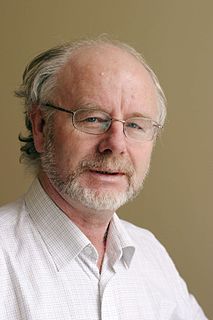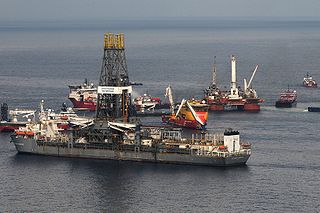Related Research Articles
A ship classification society or ship classification organisation is a non-governmental organization that establishes and maintains technical standards for the construction and operation of ships and offshore structures. Classification societies certify that the construction of a vessel comply with relevant standards and carry out regular surveys in service to ensure continuing compliance with the standards. Currently, more than 50 organizations describe their activities as including marine classification, twelve of which are members of the International Association of Classification Societies.

The Germanischer Lloyd SE was a classification society based in the city of Hamburg, Germany. It ceased to exist as an independent entity on September 2013 as a result of its merger with Norway's DNV to become DNV GL.
In fluid dynamics and elasticity, hydroelasticity or flexible fluid-structure interaction (FSI), is a branch of science which is concerned with the motion of deformable bodies through liquids. The theory of hydroelasticity has been adapted from aeroelasticity, to describe the effect of structural response of the body on the fluid around it.
Offshore concrete structures have been in use successfully for about 30 years. They serve the same purpose as their steel counterparts in the oil and gas production and storage. The first concrete oil platform has been installed in the North Sea in the Ekofisk field in 1973 by Phillips Petroleum. Since then 47 major concrete offshore structures have been built, whereby 21 of the 47 concrete substructures have been designed by Dr. techn. Olav Olsen.
Henrik Overgaard Madsen is a businessperson, engineer, Member of the Board of Aker Solutions and was chief executive officer of DNV GL between 2006 and 2015.
Knutsen OAS Shipping is a privately owned shipping company located in Haugesund, Norway. The company has a fleet of purpose-built shuttle tankers, chemical carriers and product tankers internationally. The fleet consists of 41 shuttle tankers, chemical carriers and product tankers. In 2009 the company had an onshore staff of 64 to handle projects and operation of the fleet, 430 administrative employees offshore and about 800 foreign employees.

Odd Magnus Faltinsen is a Norwegian mathematician and professor of marine technology.

Discoverer Enterprise is a fifth generation deepwater double hulled dynamically positioned drillship owned and operated by Transocean Offshore Deepwater Drilling Inc., capable of operating in moderate environments and water depths up to 3,049 m (10,000 ft) using an 18.75 in (47.6 cm), 15,000 psi blowout preventer (BOP), and a 21 in (53 cm) outside diameter (OD) marine riser. From 1998 to 2005 the vessel was Panama-flagged and currently flies the flag of convenience of the Marshall Islands.
Toisa Pisces is a Liberia-flagged well test and servicing vessel owned and operated by Sealion Shipping Ltd. She is classified by Det Norske Veritas as an oil production and storage unit.
GL Noble Denton is one of the oil and gas businesses of DNV GL, headquartered in Hamburg, Germany and London, UK. The company is an independent technical advisor to industry operators across the world.

DNV is an international accredited registrar and classification society headquartered in Høvik, Norway. The company currently has about 12,000 employees and 350 offices operating in more than 100 countries, and provides services for several industries including maritime, oil & gas, renewable energy, electrification, food & beverage and healthcare. DNV GL was created in 2013 as a result of a merger between two leading organizations in the field — Det Norske Veritas (Norway) and Germanischer Lloyd (Germany). In 2021, DNV GL changed its name to DNV, while retaining its post-merger structure.

Suction caissons are a form of fixed platform anchor in the form of an open bottomed tube embedded in the sediment and sealed at the top while in use so that lifting forces generate a pressure diffential which holds the caisson down. They have a number of advantages over conventional offshore foundations, mainly being quicker to install than deep foundation piles and being easier to remove during decommissioning. Suction caissons are now used extensively worldwide for anchoring large offshore installations, like oil platforms, offshore drillings and accommodation platforms to the seafloor at great depths. In recent years, suction caissons have also seen usage for offshore wind turbines in shallower waters.

Flexcom is a finite element analysis software package used in the offshore oil and gas and marine renewable energy industries. An educational version is also available for universities.

Valemax ships are a fleet of very large ore carriers (VLOC) owned or chartered by the Brazilian mining company Vale S.A. to carry iron ore from Brazil to European and Asian ports. With a capacity ranging from 380,000 to 400,000 tons deadweight, the vessels meet the Chinamax standard of ship measurements for limits on draft and beam. Valemax ships are the largest bulk carriers ever constructed, when measuring deadweight tonnage or length overall, and are amongst the longest ships of any type currently in service.
The Centre for Ships and Ocean Structures (CeSOS) is a research centre located at the Marine Technology Centre in Trondheim, Norway. The research centre's goal is to create fundamental knowledge about the design and operation of ships and ocean structures. The centre has been active since 2002, when it was established as a Centre of Excellence (CoE) by the Research Council of Norway and the Norwegian University of Science and Technology (NTNU). Although the financing period by the Research Council of Norway finished in 2012, research activities are still ongoing in 2013 and 2014, financed by external means.
Integrated Software Dependent Systems (ISDS) is an offshore standard (DNV-OS-D203) and recommended practice guideline (DNV-RP-D201) covering systems and software verifications and classification of any integrated system that utilizes extensive software control. The ISDS Recommended Practice (DNV-RP-D201) was launched in 2008 by Det Norske Veritas (DNV), the Norwegian classification society. DNV Offshore Standard OS-D203 launched in April 2010.

The Gülsün class is a series of container ships built for Mediterranean Shipping Company (MSC). The largest ships have a maximum theoretical capacity of 23,756 twenty-foot equivalent units (TEU). They were the largest container ships in the world when they were launched, surpassing OOCL Hong Kong. They have since been surpassed by other ships like the Algeciras class. The ships were the first container ships to feature 24 containers wide on deck.
References
- ↑ Impact - 50 years of DNV research and innovation. Det Norske Veritas, DNV Research. 2005. p. 150. ISBN 82-515-0303-5.
- 1 2 Gard Paulsen; Håkon With Andersen; John Petter Collett; Iver Tangen Stensrud (2014). Building Trust, The history of DNV 1864-2014. Lysaker, Norway: Dinamo Forlag A/S. pp. 121, 436. ISBN 978-82-8071-256-1.
- ↑ Araldsen, Per O. (January 1974). "Computers & Structures, Volume 4, Issue 1: An example of large-scale structural analysis. Comparison between finite element calculation and full scale measurements on the oil tanker Esso Norway". Computers & Structures. 4: 69–93. doi:10.1016/0045-7949(74)90077-7.
- ↑ Moss Rosenberg Verfts LNG-skip, Andre gass- og kjemikalietankere [LNG Carriers of Moss Rosenberg Verft, Other Gas- and Chemical Tankers](PDF) (in Norwegian). Stavanger Museums Årbok, Årg. 113 (2003), s. 99-120, 2004. 2004. Retrieved 30 June 2015.
- ↑ Means, Kaia (2009). Celebrating Sesam's first 40 years. DNV GL. Retrieved 2 July 2015.